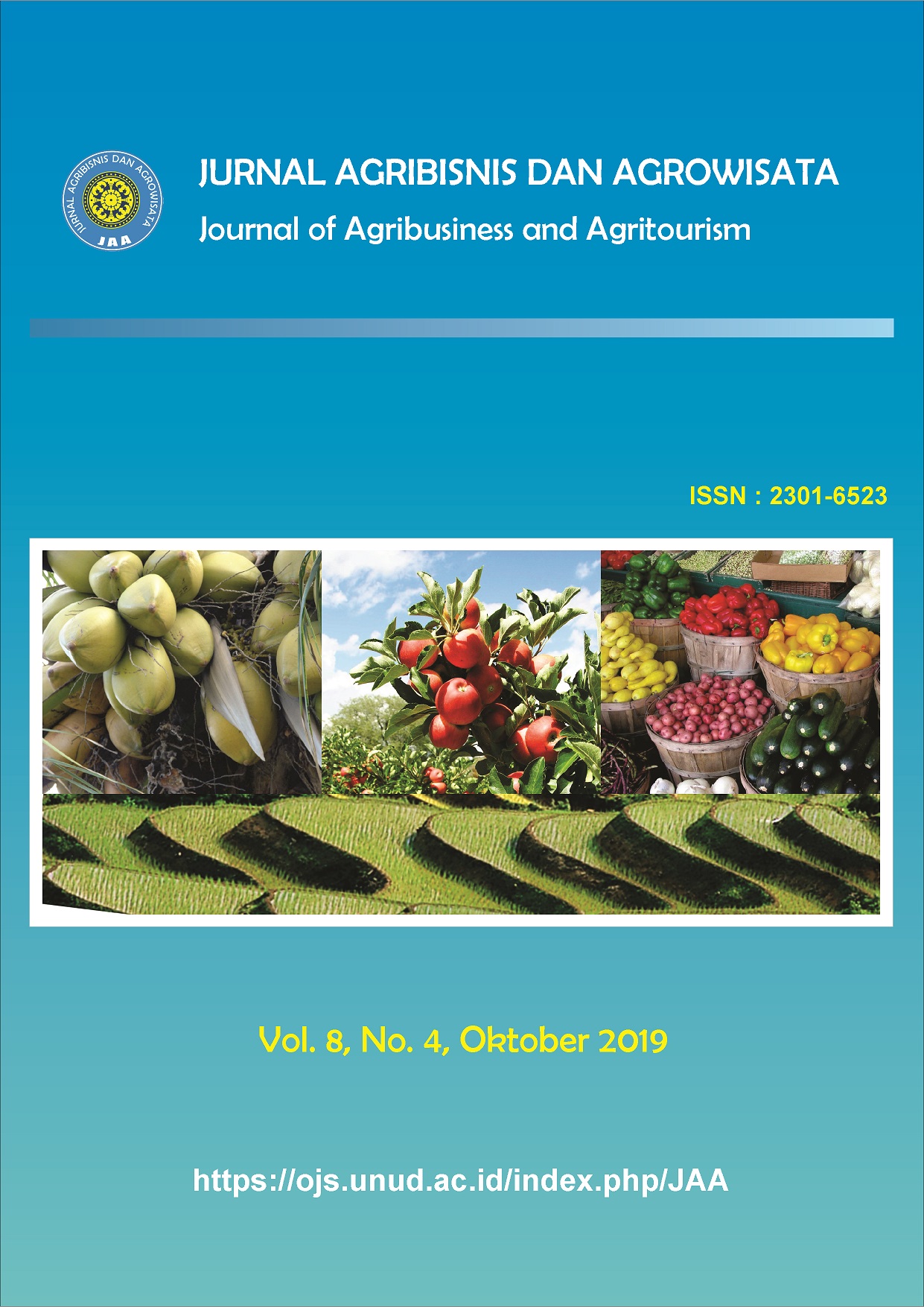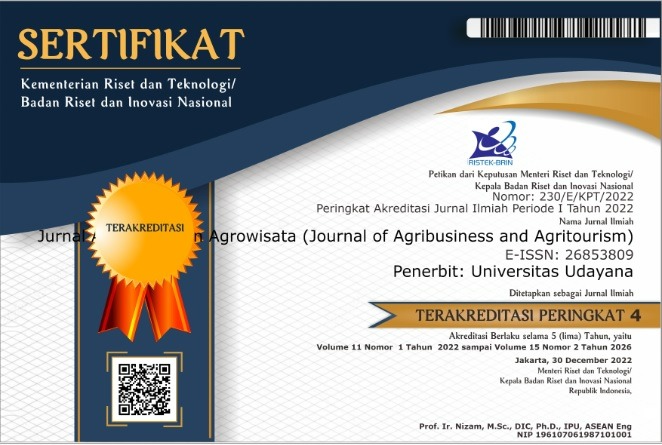Saluran Pemasaran Cabai Rawit di Kecamatan Puger Kabupaten Jember Provinsi Jawa Timur
Abstract
Marketing Channel for Cayenne Pepper in Puger Sub-District
Jember Regency East Java Province
The difference in the cayenne pepper marketing channels in Puger Sub-District, Jember
Regency has an impact on the price for producers and consumers. The selling price of
cayenne pepper at the farm level during the harvest season in July-September 2017
continues to decline and the bargaining position of farmers was considered weak. The
purpose of this study was to find out the marketing institutions and channels, marketing
functions, marketing efficiency (EP), and the ratio of the cost of cayenne pepper in
Puger Sub-District. The data used were qualitative and quantitative data. The analysis
used is descriptive qualitative and quantitative methods. The respondents of this study
were 51 farmers (Mojosari, Grenden, and Jambearum Villages) which were determined
by the proportional random sampling method and 15 marketing institution respondents
determined by the snowball sampling method.The respondents of the marketing
institutions consisted of one middleman, four sub-district level collecting traders, three
inter-city traders, and seven retailers. There are three marketing channels namely, (1)
farmers- collecting traders - retailers (Balung, Grenden, and Pasar Tanjung markets) -
consumers, (2) farmers - collecting traders - inter-city traders (Jakarta) - markets in
Jakarta, (3) farmers - middleman - collecting traders - inter-city traders (Jakarta) -
markets in Jakarta. Every marketing institution performs marketing functions, namely
exchange functions, physical functions, and facility functions. The functions performed
by each institution are different. All marketing channels in this study are efficient. The
most efficient marketing institution in the marketing channel I is the collecting
traders,onmarketing channels II, namely inter-city traders, and on marketing channels
III, namely inter-city traders with the same values as in marketing channels II. Each
channel has a collecting trader. When it was compared, the collecting traders at channel
I was the most efficient institution.
Downloads
References
Asmayanti. 2012. Sistem Pemasaran Cabai Rawit Merah (Capsicum frutescens L.) di Desa Cigedug Kecamatan Cigedug Kabupaten Garut. [Skripsi]. Bogor. Fakultas
Ekonomi dan Manajemen, Institut Pertanian Bogor.
Bungin, Burhan. 2005. Metodologi Penelitian Kuantitatif Komunikasi, Ekonomi, dan Kebijakan Publik serta Ilmu-ilmu Sosial Lainnya. Jakarta: Prenadamedia Group.
Dirjen Hortikultura. 2015. Rencana Strategis Direktorat Endral Hortikultura Tahun 2015-2019. www.Hortikultura.Pertanian.Go.Id/WpContent/Uploads/2015/06/Bab-II.Pdf(diakses pada tanggal 24 Januari 2018).
Downey, W. D. dan S. P. Erickson. 1992. Manajemen Agribisnis. Jakarta: Erlangga.
Firdaus, Muhammad. 2010. Manajemen Agribisnis. Jakarta: PT Bumi Aksara.
Limbong, W H Dan P Sitorus. 1987. Pengantar Tataniaga Pertanian. Jurusan Ilmu-Ilmu Sosial Ekonomi Pertanian. Fakultas Pertanian. IPB. Bogor.
Pusat Data Dan Sistem Informasi Pertanian. 2016. Outlook Komoditas Pertanian Sub SektorHortikultura.Http://Epublikasi.Setjen.Pertanian.Go.Id/Epublikasi/Outlook/2016/Hortikultura/OUTLOOK%20CABAI%202016/Files/Assets/Common/Dow
nloads/OUTLOOK%20CABAI%202016.Pdf (diakses pada tanggal 4 Januari 2018).
Suryani dan Hendryadi. 2015. Metode Riset Kuantitatif: Teori dan Aplikasi pada Penelitian Bidang Manajemen dan Ekonomi Islam. Jakarta: Prenadamedia Group.
Tatiek. 2012. Lembaga, Saluran, Dan Fungsi Pemasaran Dalam Tataniaga Agroproduk.Http://Tatiek.Lecture.Ub.Ac.Id/Files/2012/11/Bab3.Pdf(diakses pada tanggal 17 Januari 20







